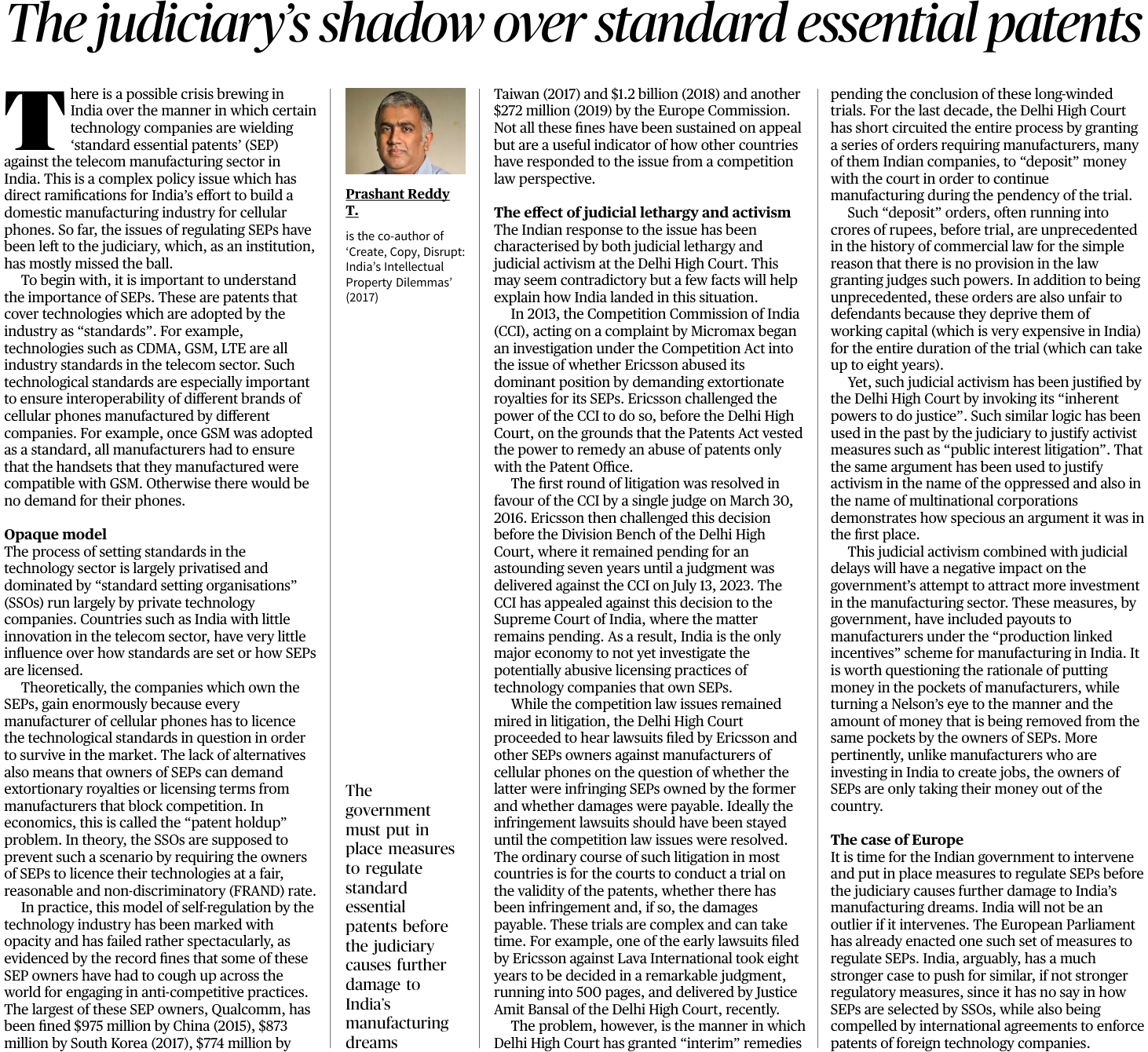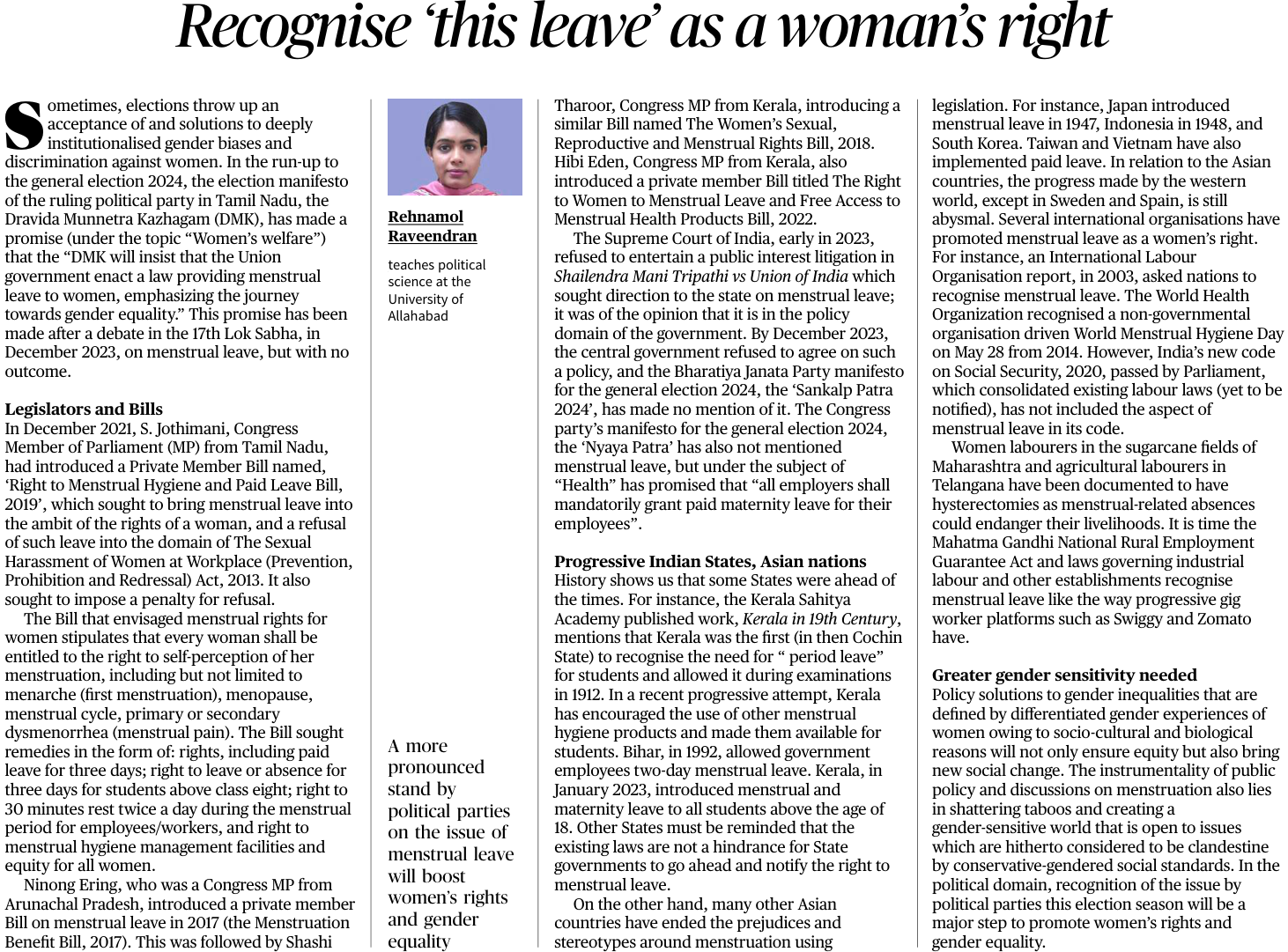 |
|||
| Editorial Analysis
3 May 2024 |
|||
|
Crisis Brewing in India: Technology Companies and Standard Essential Patents

Introduction;
- Description of the issue: Potential crisis in India over the wielding of Standard Essential Patents (SEPs) by technology companies against the telecom manufacturing sector.
- Implications: Direct impact on India’s efforts to develop a domestic manufacturing industry for cellular phones.
Understanding Standard Essential Patents (SEPs)
- Definition and importance: SEPs cover technologies adopted as industry standards, ensuring interoperability in cellular phones.
- Privatized standardsetting process dominated by Standard Setting Organizations (SSOs).
Challenges with the Current Model;
- Patent holdup problem: Lack of alternatives leading to extortionate royalties and anticompetitive practices.
- Failed selfregulation by the technology industry, evidenced by record fines imposed globally.
Effect of Judicial Response
- Judicial lethargy and activism at the Delhi High Court.
- Delayed response to competition law issues regarding SEP licensing practices.
- Unprecedented “interim” remedies impacting manufacturers’ working capital.
Impact on Manufacturing Sector;
- Negative effect on government’s efforts to attract investment in manufacturing.
- Questioning the rationale of incentives to manufacturers while neglecting SEP regulation.
Case of Europe;
- European Parliament’s regulatory measures for SEPs.
- India’s need for similar or stronger regulatory measures due to lack of influence in standard selection and international patent enforcement agreements.
Conclusion;
Urgency for Indian government intervention to regulate SEPs. Imperative to prevent further damage to India’s manufacturing aspirations.
Advancing Gender Equality: The Menstrual Leave Debate in India

Legislators’ Efforts and Bills;
- Overview of legislative attempts: Private Member Bills introduced by various Members of Parliament (MPs) such as S. Jothimani, Ninong Ering, Shashi Tharoor, and Hibi Eden.
- Description of the proposed Bills and their objectives regarding menstrual rights and entitlements for women.
Judicial Response and Government Stance;
- Supreme Court’s refusal to entertain a public interest litigation on menstrual leave, stating it’s within the policy domain of the government.
- Central government’s refusal to agree on a policy for menstrual leave by December 2023, as reflected in the Bharatiya Janata Party and Congress party manifestos for the 2024 general election.
Progressive Initiatives in India and Asian Countries
- Historical context: Kerala’s early recognition of period leave in 1912 and recent initiatives like introducing menstrual and maternity leave for students.
- Comparison with Asian countries: Legislative efforts in Japan, Indonesia, South Korea, Taiwan, and Vietnam to address menstruationrelated issues.
- Critique of progress in the western world, excluding Sweden and Spain.
Challenges Faced by Women Laborers;
- Documentation of menstrualrelated absences leading to hysterectomies among women laborers in Maharashtra and Telangana.
- Advocacy for recognizing menstrual leave in labor laws such as the Mahatma Gandhi National Rural Employment Guarantee Act and industrial labor laws.
Call for Greater Gender Sensitivity;
- Importance of policy solutions addressing gender inequalities rooted in sociocultural and biological factors.
- Role of political parties in recognizing menstrual leave as a step towards promoting women’s rights and gender equality.
Conclusion;
The significance of menstrual leave in challenging taboos and promoting gendersensitive policies. Implications of political parties’ acknowledgment of the issue for advancing women’s rights in India.
Charting the Course: Building Viksit Bharat through Strategic Diplomacy

Introduction;
- Overview of the pathway to achieving Viksit Bharat (Developed India) in the next 25 years.
- Emphasis on the importance of a clear national vision, political stability, and international environment.
Strategic Foreign Policy;
- The shift towards a “Bharat First” approach since 2014, focusing on national interests and multivector diplomacy.
- Emphasis on maximizing partnerships and minimizing challenges, with a strong assertion of India’s relevance in global affairs.
Promoting National Strengths;
- Importance of expanding manufacturing and technology as foundations for national development.
- Need for leapfrogging in critical and emerging technologies through international collaboration and effective diplomacy.
Strategic Autonomy and Security;
- Quest for strategic autonomy in the postCovid world, emphasizing the importance of “Make in India” for economic and national security.
- India’s potential as a global hub for research, design, and innovation, facilitated by intensive engagement with international partners.
Harnessing Indian Skills and Talent;
- Recognition of Indian skills and talent, enhanced by trust and transparency in the digital domain.
- Expansion of education and training capacities to meet new demands, with a focus on compatibility with Indian values and practices.
Connectivity and Resilience;
- Implications of conflict and climate change for connectivity and logistics, necessitating derisking through international collaboration.
- Focus on key initiatives like the IMEC corridor, INSTC, and Trilateral Highway to enhance connectivity.
Security and Political Balances;
- India’s engagement in initiatives like Quad, BRICS, I2U2, SCO, and East Asia Summit to ensure security and political balances.
- Importance of a Vishwa Bandhu (Global Friend) approach to navigate partnerships and conflicts effectively.
Conclusion;
The critical role of strategic diplomacy in building Viksit Bharat, emphasizing national interests, partnerships, and resilience in a changing world.

